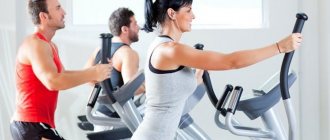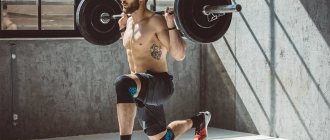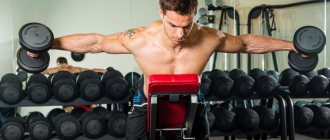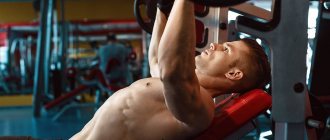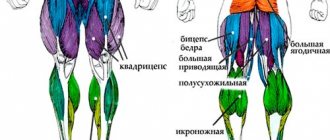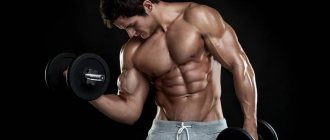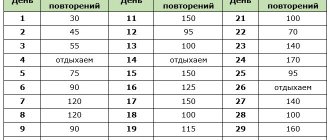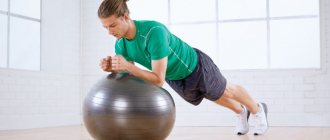Girls want to be slim, guys want to be big and strong. Regardless of your goal, you probably want to get toned abs. And this is a great desire. However, there is a problem. You've probably noticed that there are a lot of thin people, but without abs.
And here experienced marketers come to the rescue, hiding in the shadows or hovering overhead, looking for confused prey. Okay, this all sounds a little dramatic, but look at the situation.
The problem is that there is a lot of false advice on how to get six-pack abs in 30, 15 or even 10 days.
- Some people say you just need to do special abdominal exercises every day... and they are wrong.
- Others say you just need to do squats and deadlifts to get great abs... and they're wrong.
- Still others argue that you need to give up certain foods... and again they are wrong.
- The fourth seems to be closer to the truth: you just need to have a low percentage of body fat... but this is not true either.
- Still others insist that you need to take the right sports nutrition... but they are simply lying.
In fact, to lose belly fat and pump up your abs, you need to adhere to two rules, which I will discuss below. Go!
How to pump up your abs - 2 simple rules
It's not difficult to pump up your abdominal muscles. But any abdominal training program will be ineffective if you do not adhere to the following principles.
Burn belly fat
I figured I'd start with the obvious. The main reason you don't have visible abs is because you have too much fat in your abdominal area ( belly ). Get rid of excess fat deposits - and you will become closer to your goal or even achieve it altogether. The question arises: how to burn fat correctly?
Firstly, local fat burning is impossible. The myth about targeted fat burning is actively used by manufacturers of various exercise equipment (abdominal belts), magazine publishers and authors of pseudoscientific websites. Allegedly, there are special exercises for the legs, for example, and the same exercises for the abs that will help you quickly achieve your goal.
I wish it were that simple. However, science says otherwise. Research [1] has shown that training a specific muscle group results in increased levels of blood flow and lipolysis (the conversion of fat cells into fuel for the body) in that area, but these effects are miniscule.
Exercising muscles burns calories and can lead to muscle growth, which helps in fat loss. However, it does not directly reduce the fat layer covering them [2].
You see, fat burning is a process that takes place in the body as a whole.
If you maintain a calorie deficit (read here how to do it correctly), your body reduces fat reserves. Fat burning occurs everywhere, but in some areas it is faster (more on this below).
The point is, you can do hundreds of crunches every day, but you won't see a six-pack [3] until you have a certain percentage of body fat - 15% or lower for men, 25% or lower for women . The images below show everything clearly.
As you can see, the cubes begin to show through around 15% and 25% in men and women, respectively. They are really clearly visible when the fat percentage is less than 10 in men and below 20 in the fair sex.
I mentioned above that some areas of the body lose fat faster than others . Unfortunately, belly deposits are incredibly stubborn. And I'm not talking about a person, but about physiology.
There is a scientifically proven reason why fat cells in certain areas of the body are much more difficult to burn than others. Such areas, including the abdomen, contain many more alpha receptors than beta, which slows down the mobilization of fat deposits [4]. But there are also specific methods to combat this. You will learn about them in the following articles on Zozno.
Pump up your abdominal muscles
It is generally believed that people who do a lot of heavy compound exercises (squats, deadlifts, military presses, etc.) do not need abdominal training. I don't agree with this. To understand why, let's take a quick look at the structure of the abdominal muscles.
The main muscle that is associated with six-packs is the rectus abdominis.
There are also several other core muscles that complete the look, including the obliques, transversus abdominis, and serratus anterior:
The importance of developing these muscles in addition to a beautiful rectus abdominis should not be underestimated. Look at this photo - like “pumped up” abs and clearly lagging core muscles (torso muscles).
This is not a bad physical condition, but there is no visible waist taper, serratus anterior, or transverse muscles.
Some people have the opposite problem: their rectus abdominis is underdeveloped, but the rest of the abdominal area is overinflated. Here's an example:
This can happen if the obliques are overdeveloped, the rectus abdominis is lagging behind, and there are no transverse muscles and/or serratus anterior at all.
Now let's see what a well-rounded core looks like.
Sure, the model (Greg Plitt) has much better genetics than the two guys above, but he's not much drier than the second one here. He just has the perfect ratio of the rectus abdominis and other core muscles.
Any other tips on how to get toned abs?
Actually, there are no more tips for pumping up your abs. Whether you're a guy or a girl, you need to have a low body fat percentage and strong core muscles. The first goal is achieved through proper nutrition with a calorie deficit, and the second through basic and isolation exercises.
Abdominal muscle anatomy
The muscle mass is divided into groups: rectus muscle, oblique muscle, transverse muscle. The rectus muscle includes the size of the entire anterior abdominal wall. Its tendons and joints form squares - cubes, forming a relief. The main job of this muscle is to support the back vertically and regulate inclinations.
The external and internal oblique muscles are used when turning and bending the body. The external ones are located in the lower abdomen, passing obliquely to the lower ribs. The internal ones are located under the external ones. The transverse group (muscles look like thin leaves) is involved in the human respiratory system. The abdominal muscles are abdominal muscles and are part of the core muscles.
Core muscle
Under this name there is a complex of muscles that stabilize the pelvis, hips, and spine. The complex includes:
- small and medium muscles of the buttocks;
- adductors;
- muscle under the spine;
- abdominal muscles (obliques, transverse, rectus);
- brachialis coracoid muscle;
- back of the thigh, etc.
With any movement, the core muscles contract. An effort of a weak or strong nature involves the torso and limbs and depends on the training of the impulses. Correct posture can be maintained by maintaining the spine in a straight position at all times, with conscious fixation. The straight plank exercise allows you to train the supporting (core) muscles, strengthening the abdominal muscles.
The basis of the exercise algorithm is as follows: you need to lie face down on the floor. Then raise the body, leaning on the limbs of the arms from the hand to the elbow and the tips of the toes. The feet are connected. Legs and buttocks are straight and tense. Contraction of the gluteal muscles enhances the effect. Holding the body suspended for the number of seconds that will cause fatigue. Stability of the trunk and pelvis is the basis of training for sports disciplines. When training the core muscles, focus on the groups of the abdomen, back, area between the shoulder blades, buttocks, and legs.
There is no top and bottom of the press, it is loaded all at once
There is a misconception expressed in the fact that there is a top and a bottom of the press. It is baseless. The rectus muscle, called the abs, is one. It contracts completely when movement occurs, or is completely at rest.
When pumping, the upper and lower regions of the rectus muscle are worked out, but these segments develop differently due to the unequal number of nerve endings. Abdominal contraction in the sternum area is stronger than in the lower abdomen. Basic exercises and targeted loads affect the development of the lower segment. Therefore, after enough training, the lag in the lower part becomes less significant, and the abdominal muscles work more evenly.
The best exercises to pump up your abs
I've seen many people with poorly developed abs who can do hundreds of crunches and plank for an impressive amount of time.
The problem here is that the core muscles are like any other muscle. They need progressive overload to grow. This requires an emphasis on weight training and increasing athletic performance over time.
One of the biggest mistakes when training your abs is not doing exercises with additional weight. As you'll see below, I recommend doing at least a few sets of these exercises during your training. However, before we model the workouts, let's talk about the individual exercises.
There are an incredible variety of abdominal exercises and a lot of opinions about what is best and what is not. Luckily, you only need to pick a few to develop your core muscles.
The exercises below are based on scientific research [5] and my personal experience. There are many more options you can make, but you're unlikely to need them.
Multi-joint exercises
The squat, deadlift, bench press and military press are not abdominal exercises per se, but they do strengthen your core. They are also extremely important for the growth of muscle mass and strength throughout the body. If you don't do them every week (or don't pay enough attention), you won't see good progress.
Crossover crunches
Crossover crunches are one of my favorite exercises because they involve weights and work the entire rectus abdominis muscle.
You can also use crunches to work your obliques by doing a side rep after your regular rep. By lateral repetition I mean touching your right elbow to your left knee and vice versa.
It turns out: regular repetition, right elbow to left knee, regular repetition, left elbow to right knee.
Leg raises
Leg raises are one of the best exercises for developing the rectus abdominis muscles, including the “lower abs,” as well as the oblique muscles. In the beginning, you can perform the exercise with your knees bent, but your goal is to work with your legs straight. After a while, you can add weight by placing a dumbbell between your legs.
Hanging Leg Raise
The hanging leg raise is similar to the previous exercise, but it requires more effort on your part to stabilize your body. Again, you can work with your knees bent at first, but you should aim for straight legs. And hanging leg raises with dumbbells will make you really sweat.
"Bike"
The bicycle exercise is a great addition to your abdominal workouts and works especially well on the obliques and transverse muscles.
Ab roller
I'm not a fan of various training devices, but the gymnastic roller is a good thing for pumping up the abs.
Abdominal exercises for men at home
It will be very easy to pump up a man’s abs at home, because the beauty of training is that you don’t need a huge amount of exercise. It is enough to perform 1-2 complex exercises, as well as one for each area of the abs (despite the fact that the rectus abdominis muscle is a single section, for better development it is usually trained from different directions).
All movements are divided into:
- Bringing the body to the legs;
- Bringing the legs to the body;
- Complex.
The first group works the so-called “upper abs”, the second – the lower part. Compound exercises work almost all of the abdominal muscles, although such exercises are few and far between.
Upper press
Let's look at the best abdominal exercises for men, especially for the upper part.
Crunches
Ab crunches for men are a universal exercise that can be performed both on the floor and on a bench or even a fitball. Works out the abs perfectly, but only if done correctly. Technique:
- Lie on the floor with your knees bent. Hands are clasped at the back of the head, elbows pointing to the sides;
- Slowly begin to lift your upper back, lifting your shoulder blades off the floor;
- At the peak point, exhale and hold for 1 second, then return to the starting position.
It is important to keep in mind that crunches are not the usual seated sit-ups found in school physical education classes.
This movement is performed slowly and concentrated. Moreover, a number of conditions must be taken into account:
- You should lower yourself at the same speed as you raise your body;
- Do not lie down completely on the floor, only until your shoulder blades touch the surface;
- Maintain tension in your abdominal muscles throughout the entire approach;
- Exhaling at the peak allows for better muscle contraction.
Exercise "prayer"
A powerful abdominal exercise for men that works the abs incredibly well. Can be performed at home with training harnesses. Technique:
- Sit so that the emphasis is on the front of your shin. Attach the tourniquet to the horizontal bar or any other support and take it in your hands (to feel the tension). Fix your hands at forehead level;
- Begin to slowly lower your body down, tilting your head and body towards the floor. The back should be straight;
- Try to bring your elbows to your knees, and then return to the starting position.
Adjust the tension of the harness so that there is noticeable tension when lowering the body.
Lower press
For a man’s lower abs, there are two extremely effective exercises that will be fully sufficient to build powerful muscles. This is a leg lift while hanging and lying on the floor. The second movement can be done in any conditions, but for the first you will need a horizontal bar or crossbar at the nearest sports ground.
Lying leg raise
- Lie on the floor with your arms along your body (if it is difficult to lift your legs, you can place them closer to your buttocks, providing additional support). Legs brought together;
- Slowly raise your legs until your legs and body form a right angle;
- Take a short pause and lower your legs down.
It is important not to lower your legs to the floor, but to leave them suspended in order to maintain tension in the muscles.
Hanging leg raises are performed according to the same principle, but with the difference that the body is in an upright position. It is also important to remember that to avoid a situation where the legs take the entire load from the lower abdomen, it is better to lift them with bent knees.
Complex exercises for men: pumping up the abs at home
There are very few complex abdominal exercises for men, but they provide an even load on all muscles.
Exercise "book"
Performed on a chair or bench:
- Sit on the edge of the bench, put your feet forward and move your body back a little. Place your hands on the seat;
- At the same time, pull your knees bent towards your body and your body towards your legs. The more you can “fold”, the more effective the exercise will be.
The “book” can also be done on the floor, but it is important to remember that your back and legs should not touch the floor. Support points are buttocks and arms.
Obliques
There is no need to perform any separate exercises for the oblique muscles. To fully load them, you need to add body rotation to your normal movements.
In crunches, this is the inclination of the body first to one hip, then to the other. While hanging, the legs are raised not in front of you, but with abduction to the sides.
Rules for training the press
The rules for abdominal training are very simple.
Combine exercises with and without weights
Well-rounded abs require a lot more muscle development than most people realize. Alternating exercises with and without additional weight is the most effective way to do this.
Train your abs often
How often can you pump up your abs? The optimal frequency of training is the subject of endless debate, but in general, small muscle groups recover faster than larger muscle groups [6]. Heavy exercises like squats and deadlifts take longer to recover than isolation exercises like dumbbell curls or dumbbell lateral raises. I've found that abs (as well as calves, by the way) can be easily trained 2-3 times a week in addition to basic training. This is the optimal frequency that will not lead to overtraining. Of course, you shouldn't train your abs for three days in a row. There should be 1-2 days of rest between classes. Personally, my schedule is Monday, Wednesday and Friday with three basic workouts per week and Tuesday and Thursday if I train twice.
Progress in exercises
As in training any other muscle groups, your goal in training “cubes” is to gradually progress and improve. Add pounds when doing exercises with dumbbells (extra weight) and increase the number of repetitions when doing bodyweight workouts.
How long does it take to pump up your abs?
There is no universal amount of time for strengthening and developing the abdominal muscles. There are various factors influencing the process:
- Fat layer. The abdominal muscle group is not easy to correct due to fat deposits. Cashing out muscle relief is available with a one-centimeter layer.
- Gender of the trainee. Men have a higher ability to quickly pump up their abs than women due to the greater amount of testosterone in the body.
- Physical fitness. Beginners to the sport will have to take longer to develop muscle mass. Whereas an athlete will cope with this task faster.
With sufficient stubbornness in moving towards the goal - getting the coveted cubes - the prospect is still not short-term.
The body slowly adapts to the processes occurring in the body if it is not supplied with drugs. They cannot be a panacea for accelerating development, since an athlete can get disqualified, and a beginner, instead of gaining, can lose health. Expert advice: be patient and slowly and methodically achieve results.
How to build an ab workout
So, you know the basic rules, now let's see how best to build abs training. It's simple - you need to do circuit training, which consists of three exercises performed one after another. You will rest between circles and then repeat them.
Here's how circuit training should go:
- Do 1 set of weight-bearing exercises, such as crossover crunches, push-up leg raises, or hanging leg raises, for 10 to 15 reps. This means that if you can't do more than 10 reps, the weight is too heavy. But if you can do more than 15, it's time to add another 2 kg.
- Immediately perform any bodyweight exercise to failure.
- Without rest, do another bodyweight exercise to failure.
- Rest between circles – 2-3 minutes.
For example, here is my abdominal training program:
- 1 set of crossover crunches, 10-12 reps;
- 1 set of leg raises, to failure;
- 1 set of bicycle exercise, until failure.
- rest 2-3 min.
I usually do these circuits between sets of large muscle group exercises to save time. Eg:
- 1 deadlift approach;
- 1 circle for the press;
- rest 60-90 seconds;
- 1 deadlift approach;
- 1 circle for the press;
- rest 60-90 seconds.
And so on. I recommend doing 3 laps per workout (2-3 times a week) . As you'll see, it's harder than it looks!
How to make your path to perfect abs easier?
Simple recommendations:
- Training can be done frequently. The load is divided (by muscle group) per day into several approaches in the morning and evening. During the day, repeat the “Vacuum” exercise (holding the lower abs in a tense state for the longest time).
- You can pump up your abdominal muscles without special equipment or devices at home. No special weighting is required either. It is enough to master exercises with your own weight: twisting, lifting, folds and the like.
- Increase the volume of load gradually: the number of repetitions of exercises relative to the number of approaches. Use a super set for many exercises (consecutive execution without a break, one after another). In a super set, the body lift and folds alternate well.
Ideal abs will not take long to appear if you follow a diet and carry out effective sports activities.
Basic rules for strengthening the press
When improving the appearance of your stomach, you shouldn’t listen to a friend about how he properly pumped up his abs. It is advisable to follow generally accepted rules and advice from specialist trainers:
- Do a warm-up that will warm up your muscles, eliminate pain and injury, and prepare you for training, regardless of where it takes place at home or in the gym.
- Set a goal and know when to stop. If you need to dry out the body (eliminate fat), then balance the nutrition. Loads affect muscle function, not the layer. If the elastic abs are being pumped up, then the exercises are carried out at a slow pace to maximize the impact. To obtain voluminous cubes, it is necessary to use weighting agents.
- Give your muscles a break to recover. The optimal schedule is considered to be 3-4 classes per week for half an hour. Beginners are recommended to train for 20 minutes 2 times a day.
- Follow the technique of doing the exercises. There will be a greater effect from 10 correct exercises than from 40 with a violation of the methodology. If during training you feel a slight burning sensation (warmth) in your muscles, then everything was done correctly.
- Tighten your abs constantly, even while inhaling, for intense pumping.
- Don't ignore muscle pain. If the pain is mild, then you can ignore it and it will disappear. If you are strong, move the workout so as not to injure the muscle tissue.
- Breathe correctly when pumping: exhale with effort, inhale with relaxation.
- Carry out the sequence of operations for the correct loads. At the beginning of the workout, pump the upper abs, then the lower, then the oblique muscles.
- Set the load gradually. You need to start with 1 approach with a small number of repetitions, gradually increasing to 4 approaches.
- Increase the intensity of your workouts by combining them into a set and speeding up the pace. For beginners, the load is increased gradually with individual exercises.
- Eat right and get enough sleep. Sleep should occur 4 hours after training. Start training by taking a break (after eating a balanced meal) for 1.5 hours.
- Do not start exercising if you feel discomfort from a cold or other illness.
- Stop looking for a more gentle training regimen. Perform the required number of repetitions, improving your fortitude and willpower.
Having strong abs is healthy and useful for realizing your capabilities in many sports. It is loaded with squats, jumping, running, twisting and develops thanks to balancing.
Proper nutrition for abs
A sports diet differs in nutritional intake, food intake and attitude towards calories. With diets aimed at losing weight, by reducing the amount of food, a person forces the body to store fat. When following a press diet for 1.5 months, a person loses 10 kg of fat, increasing muscle mass by 3 kg.
It’s nice that the grace in the abdominal area is emphasized, as the figure is corrected. A sports diet is characterized by maximum use of calories. The menu should always include dishes prepared from products containing proteins, effective fats (mono- and semi-unsaturated), fiber, and calcium.
The basis of a nutritious diet to improve your abs:
- turkey and other lean meats;
- low-fat dairy products (low-fat ones are also allowed);
- olive oil;
- legumes
- bread made from unprocessed grain;
- eggs;
- berries;
- salad vegetables (spinach and others);
- nuts;
- whey with protein;
- breakfast cereals;
- peanut paste;
- quick-brewed oat flakes (without aromatic or sweet additives).
The products on this list include substances that activate the fat-burning components natural to the body. They protect a person from harmful influences and help maintain excellent physical shape for many years.
For sports training, the main source of energy has become protein-whey cocktails with added fiber (oatmeal). Their use can be permanent.
The first 2 weeks of the press diet do not need to be supplemented with exercises. The next 4 weeks are combined with training, each 20 minutes 3 times a week. Pay special attention to fast walking, developing strength qualities and working out the abdominal muscles with the participation of all parts of the abs.
The rules of the sports diet are that you need to adhere to the eating schedule (3 main meals + 3 snacks); use a set of exercises recommended by a trainer or a program compiled by yourself to quickly build muscles; alternate breakfast, lunch, dinner and snack at intervals of 2-3 hours throughout the day.
Calorie calculator
The body's energy needs vary. It is based on individual indicators: frequency, nature and type of training; body size and weight; % fat; appetite and the like. Metabolism (metabolic processes of the body) is not a constant value, because as muscle mass increases, the level of metabolism increases.
To know how many calories the body requires at rest. you can use the formula: OOB = 66.47 + (13.75 x W) + (5.0 x H) – (6.75 x A) for men and OOB = 665.09 + (9.56 x W) + (1.84 x H) – (4.67 x A) for women, where BMR is basal metabolism; W = weight in kg; H = height in cm; A = age in years.
There is a way to determine BV that is simpler and faster than the first: BV = 10 kcal/0.45 kg of a woman’s weight or BV = 11 kcal/0.45 kg of a man’s weight. In order to pump up the abs, you need to increase the daily calorie intake by 500, and the daily intake is determined by the level of activity: ROB x 1.2 for inactive people; ROB x 1.375 for light intensity; OOV x 1.725 for increased elaboration; OOV x 1.9 for heavy load.
Effective abdominal exercises
The presence of exercises useful for the press ensures the effectiveness of exercises:
- Lifting the body. Lying on the mat, raise your body 90° (sit down), without lifting your feet from the floor. Hands behind your head or extended in front of you. The optimal range of action is 5 sets of 20 repetitions.
- Lifting the body with turns. The exercise is performed as in the first version, only the body turns to the side when lifting, alternating left and right. When doing this, it is important not to help yourself with your feet. Optimally – 5 sets of 20 repetitions.
- Folds. From a lying position, lift your legs and torso bent at the knee joint, clapping your palms behind your legs, straighten your body and legs, repeat the exercise 20 times in 5 approaches.
- Lifting on the “Roman chair” simulator. The back is placed on the back of a chair (an inclined bench with fastenings for the legs), the legs are fixed, the body is raised 90°, and the hip joint is involved in the work. Volume of work – 5 sets of 20 repetitions.
- Vacuum. Retract your stomach, tensing all the muscles of the peritoneum. Static retention time is from 10 minutes to 1 hour. Athletes do this exercise throughout the day.
What not to do and what to do. Harmful exercises
The task of the muscles is to maintain the hips, spine, and pelvis in a balanced, stable position. A person can ease the work of the press by working on his posture: sitting at a desk or computer, do not cross your legs and do not lean your body forward. Keeping your back straight, lower your shoulders and pull them back slightly.
Improving your abs can be achieved with safe exercises:
- Raising the lower limb in a hanging position. This is the exercise on which the rest are based. Perform without supporting the lower back.
- Side bridge. From a lying position on your side, lift your pelvis off the floor, tensing the muscles of your abdomen, back, and buttocks. Support on the forearm, which is placed level with the shoulder. Hold the rack for about a minute (15 seconds is possible), repeat with the other side in a mirror manner.
- Plank. From a lying position, face down, raise your torso, focusing on your forearms perpendicular to your shoulders and the tips of your toes. Hold the plank for as many seconds as your tense muscles can withstand.
- Crunches on a Fitball ball. Lying on the ball, place your hands behind the back of your head, legs shoulder-width apart, hips and body parallel to the floor, perform twists (turns of the body) alternately in both directions. 15 repetitions recommended.
What not to do with the right approach to training:
- Do not perform exercises with the lower back lifted off the surface or with rigid support.
- Do not lift your lower back off the floor when twisting, doing this with your upper body.
- Without knowing the technique of the exercise, replace crunches with an exercise without loading the lumbar region (“prayer”).
Exercises that do not develop muscles and are harmful to health are harmful. These include:
- Raising the legs straight while fixing the torso. Compression of the lumbar discs occurs. With regular damage, osteochondrosis or a hernia of the lower part of the spine may develop.
- "Jackknife". Parallel lifting of the body and legs from the floor. The abdominal muscles are tense, and the lumbar muscles are relaxed, the spinal ligaments are loaded until painful symptoms appear.
Will sports nutrition help?
No natural substance can melt fat on its own, although you can see a lot of pseudoscientific theories about this on the Internet.
Sports nutrition manufacturers often talk about increasing fat oxidation, preserving lean muscle mass, supporting thyroid function, triggering thermogenesis, altering hormone and neurotransmitter levels, reducing water retention, improving nutrient partitioning, inhibiting fat storage enzymes, and increasing enzyme levels. causing fat burning.
In reality, these are all aspects of fat loss. But this type of marketing is nothing more than an attempt to blind you with terminology and scientific half-truths in the hope that you will simply buy into the benefits of the product.
If you take a clear-eyed look at what the science says on this subject, you'll see that proper sports nutrition can really help you. But it will never compensate for poor eating habits and irregular workout routines.
